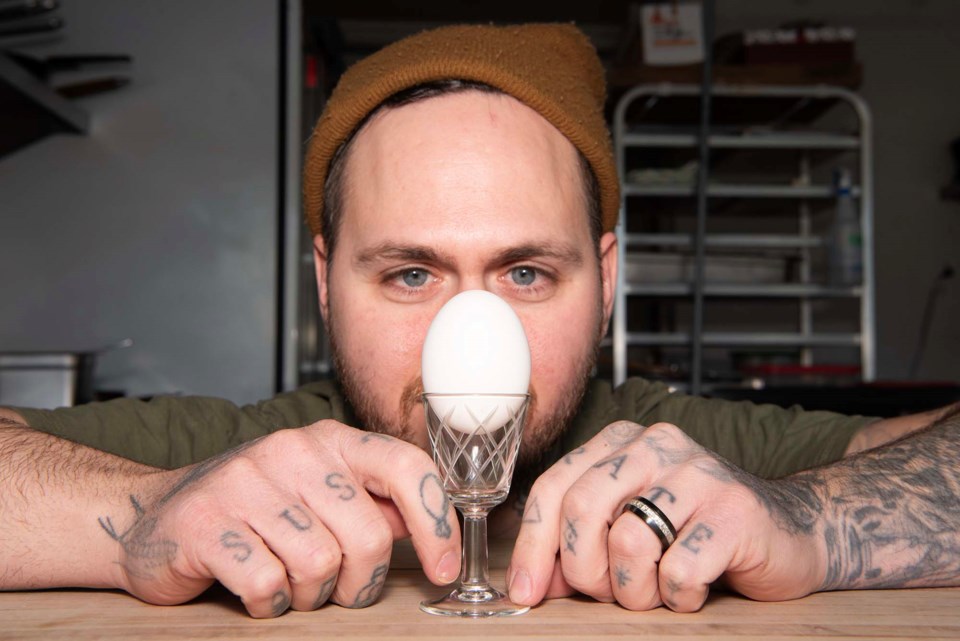Italian scientists have discovered a new way to boil eggs — a method two St. Albert chefs say is completely impractical.
Ernesto Di Maio of the University of Naples Federico II and his team of materials engineers published a paper this month in Communications Engineering on the periodic cooking of eggs.
Eggs in the shell are challenging to cook because the yolk and albumen (the egg white) reach optimum textures at two different temperatures: 65 C for yolk and 85 C for albumen, Di Maio said in an email interview. Some chefs will cook yolk and albumen separately, but this is exceedingly complex. Others use the sous vide method of cooking the egg for an hour at about 65 C, which results in all parts of the egg having the same creamy texture but leaves the albumen underdone.
Di Maio said he and his team heard of this culinary conundrum and, as scientists who study the structure of materials, wondered if they could cook both parts of the egg at their ideal temperatures without cracking open the shell.
“It was a matter of final taste, but it was also a matter of science. The best way to start a project.”
Egg-cellent research
Di Maio said his team used math and knowledge they gained from working with plastic foams to invent “periodic cooking.” Instead of applying constant heat, as happens with sous vide and boiling methods, periodic cooking sees the chef flip the egg between boiling and 30 C water every two minutes for 32 minutes. This rapidly shifts the temperature of the albumen between 100-87 C and 30-55 C while keeping the yolk at an average 67 C — just about ideal for the yolk.
Di Maio and his team cooked about 300 eggs (served to family and friends) using the periodic, sous vide, hard-boiled, and soft-boiled methods. The eggs were tested for taste and nutritional content using human taste-testers, infrared spectroscopy, and other techniques.
The team determined periodic eggs had albumen that was softer and sweeter than hard-boiled ones and whiter than sous vide and soft-boiled. Periodic yolks were less powdery, pasty, and dense than hard-boiled ones and nearly identical to sous vide. Periodic eggs contained more polyphenols than the other ones, suggesting they may be more nutritious.
“We like to say this [periodic] egg gives you the best of both worlds,” Di Maio said: the fully set and white albumen of hard-boiled combined with the creamy yolk of sous vide.
“As a consequence, yes, it definitely tastes good.”
Di Maio’s team said this cooking technique could have applications in the curing, crystallization, and structuring of other materials.
Too complicated, say chefs
Toast Breakfast & Lunch owner Ann Brady said periodic cooking was not practical in a restaurant setting. She typically gets good results by boiling eggs for three, four, or six minutes, depending on the desired doneness.
“Who would take 30 minutes to cook a boiled egg?” she asked.
After reading Di Maio’s study, WildRoots Bistro chef Tony Tipping said he did a head-to-head test of periodic cooking by serving periodic and traditional hard-boiled eggs to six of his employees. All six preferred the traditional eggs.
“I think this [technique] is a huge waste of time on so many different levels,” he said.
Tipping said periodic cooking would be exceedingly challenging to perform consistently, as even slight differences in equipment and timing would affect the results. It’s also unnecessary, as chefs can already get excellent boiled eggs by cooking them sous vide in advance and heating them up as needed.
For best results, Tipping recommended letting eggs sit at room temperature for an hour before cooking them in lightly boiling water for six minutes and 20 seconds.
Di Maio’s study can be found in the Feb. 6, 2025, issue of Communications Engineering.




